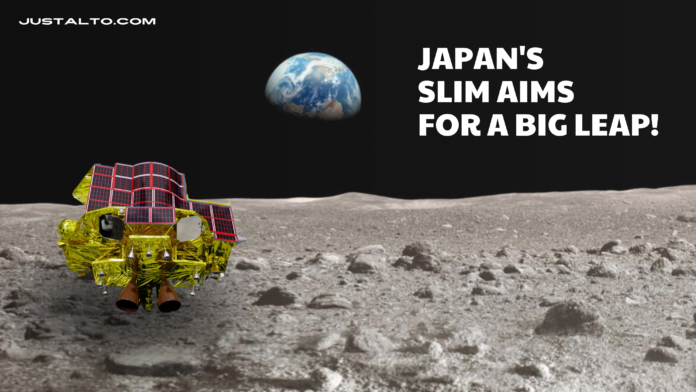Get ready to blast off, space enthusiasts! Slim (Smart Lander for Investigating Moon), Japan’s ambitious lunar mission, is en route to the moon, ready to attempt a historic landing. Slim isn’t just planting a flag; armed with cutting-edge technology and a desire to discover lunar secrets, he’s aiming for a scientific jackpot.
But why the moon, again? Well, this celestial rock contains a wealth of information about the early solar system, Earth’s formation, and even the possibility of life beyond our planet. However, landing on its surface is not an easy task. Only half of all attempts have been successful, making the competition between countries and space agencies intense.
Undeterred by the odds, Japan is taking a unique approach with Slim. Consider a smart, tiny lander equipped with a lightning-fast image processor and a keen eye for craters. That’s Slim! As it approaches the moon, its onboard computer will frantically compare live images to pre-loaded maps, pinpointing its location with incredible precision. This “vision-based navigation” is equivalent to having a lunar GPS that can land you within 100 meters of your destination – that’s some serious precision!
Slim, however, is about more than just landing; it is also about science! Slim, once safely on the lunar surface, will focus its scientific camera on Shioli, a nearby crater. This crater holds clues about ancient volcanic activity and the presence of water ice—a key ingredient for life as we know it.
And the fun does not end there! Two tiny rovers, each smaller than a shoebox, will be deployed to explore the crater’s surroundings, collecting data and taking close-up photographs. Consider these agile robots navigating the lunar terrain and returning stunning images that will give us a front-row seat to the moon’s hidden wonders.
If successful, Slim will join an elite group of moon landings that includes giants such as the United States, Soviet Union, China, and India. This would not only be a victory for Japan, but also a significant advancement in lunar science. We could discover new details about the moon’s composition, its ability to support life, and even pave the way for future human missions.
So keep an eye out for updates on Slim’s journey. This isn’t just another space mission; it’s a thrilling race against gravity, a search for scientific knowledge, and a demonstration of human ingenuity. Let’s cheer for Slim as it makes a giant leap for humanity (and moon-kind!) and brings us closer to solving the mysteries of our celestial neighbor.
Remember, this is only the beginning! Who knows what amazing discoveries await us on the moon? The future of space exploration looks promising, and Japan’s Slim is leading the way, one crater at a time.
FAQS
Japan’s current moon mission is called Slim (Smart Lander for Investigating Moon). It aims for a precision landing near a crater named Shioli, using advanced technology to touch down within 100 meters of its target.
SLIM will land on a slope near the equatorial crater Shioli. This location was chosen for its scientific potential and relatively smooth terrain.
The Apollo 11 mission that landed the first humans on the Moon in 1969 is widely considered the biggest moon mission in terms of historical significance and scientific impact.
Japan’s first lunar mission was the Hitomi satellite, launched in 1998. Unfortunately, it lost contact with Earth shortly after launch, making it a tragic but significant step in Japan’s space exploration journey.
Japan’s equivalent to NASA is the Japan Aerospace Exploration Agency (JAXA). It’s responsible for Japan’s space program and research, including the Slim mission.
Both missions aim for lunar landings, but they have key differences:
Focus: SLIM prioritizes precision landing technology, while Chandrayaan-3 focuses on scientific research and deploying a rover.
Landing site: SLIM targets a specific slope near Shioli, while Chandrayaan-3 landed in a complex lunar terrain near the South Pole.
Timeline: SLIM took a longer, fuel-efficient route, while Chandrayaan-3 followed a shorter, direct path.
The total cost of the Slim mission is estimated to be around 18.5 billion yen (approximately $158 million).

